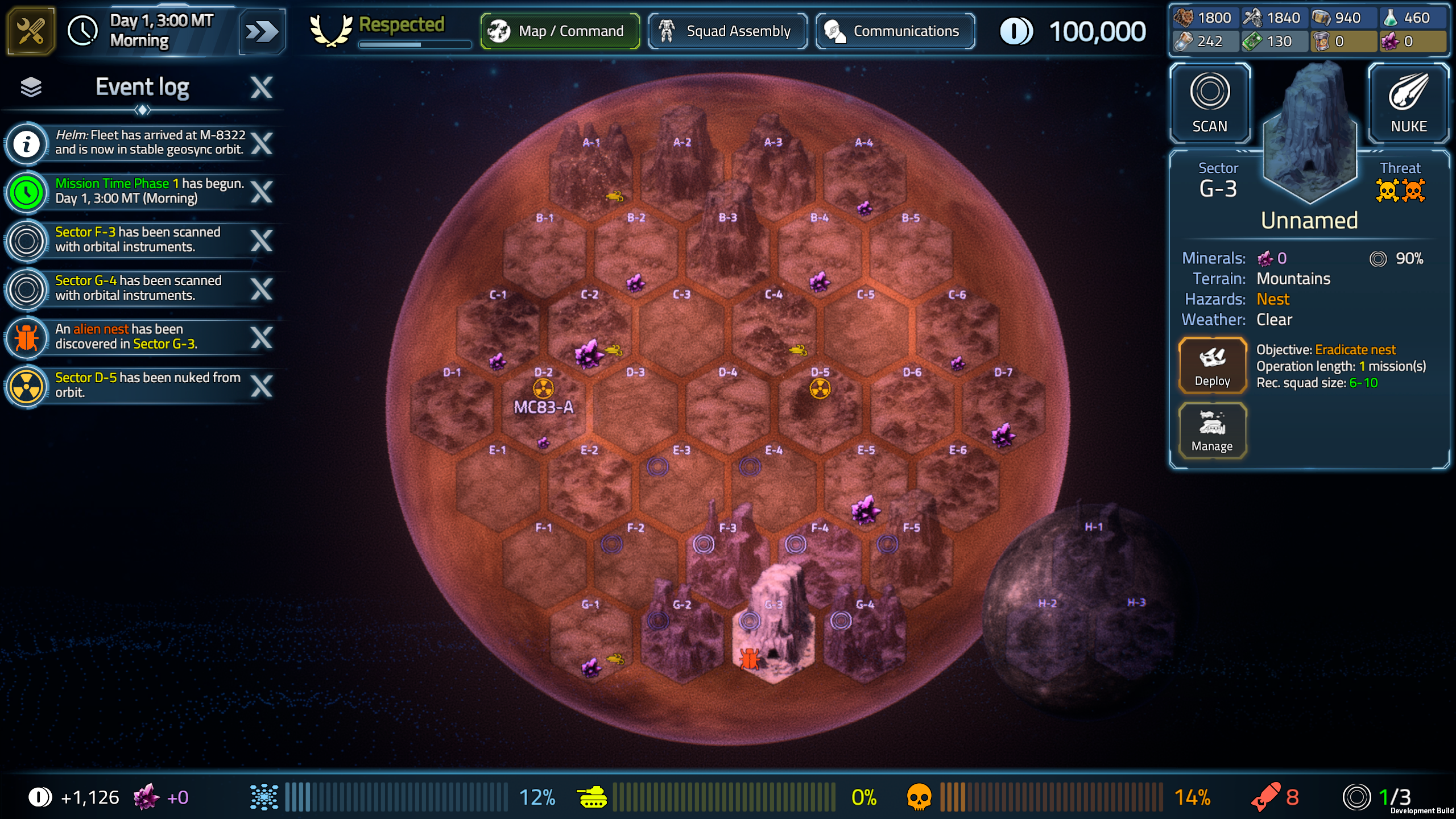Hey Marines!
The Campaign is progressing nicely, and we're still burning the midnight oil on it. As we explained in our previous Dev Diary, it includes a grand strategic layer on a planet map. And it's high time to talk about the planet map and how it works. Let's dig into the general mechanics and strategic map layer in today's dev diary!
General Campaign mechanics
The Campaign progress in USC: Counterforce will be completely separate from the other game modes. This means you don’t need to unlock items or gather resources before you can attempt a playthrough, as all content will be available to you from the start—though some items or options will be tied to other Campaign-specific conditions. The Campaign will feature a partly narrative-driven, open-ended story that plays out on a planetwide strategic map, allowing for a great deal of tactical and diplomatic choices along the way, as well as for managing your inventory and units on a persistent basis. Your marines will gain XP and ranks, your items and ammo will deplete and need to be restocked by looting during missions and crafting, and the dead will stay dead (but, of course, you’ll be able to reload a previous save unless you play on “Hardcore”).
The strategic layer
There will be a lot happening on the strategic map. Time in the Campaign is divided into Mission Time Phases (MP for short), each taking up 3 Earth hours, adding up to a total of 15 hours per day on M-8322, consisting of 5 distinct daylight phases. An MP is like a Turn during a mission, but on a global scale: when you’ve performed every action you wanted, you pass it, and the next MP begins—and between the two, of course, the aliens and the environment also get their “turns.” Alien hordes will move, join together, or disappear into subterranean caves, nests will grow, evolve, and expand to neighboring sectors; sandstorms and electromagnetic storms will pass through the desolate wastes of the planet.
In your turn, you can scan the surface to discover ruins and nests, or pinpoint the movement of hordes. You can utilize your nuclear arsenal from orbit to obliterate the surface of any sector—but be warned! Not only do you have a limited supply of nuclear warheads, but bombing left and right has other, long-term consequences, both trivial and latent.

You can also take direct control of any sector by landing squads and establishing an outpost. You can use these to set up defenses in anticipation of a horde passing through, or, what is even more important, to start mining Deothonit, the single most valuable material in the known universe (also the most valuable crafting material in the game, that can be converted into anything except Asura-49, which comes from alien specimens). Base building mechanics are based on the Defend the Base! game mode, but instead of having to defend a base wave after wave, you can pop in and out to manage it, and an actual “defense phase” will only take place when it is attacked. Building bases and mining is a good way to gather crafting materials, but it’s not mandatory. There are other ways to get enough supplies if base management is not your cup of tea, or you just prefer another approach in a playthrough.

Sending squads to the location of known nests or hordes to attack them directly is also an option. Nest-busting missions are multi-phase operations where you have to infiltrate an underground cave system. From time to time, other mission options will also pop up: you can be contacted by USCF Command or one of the mega-concerns to help their bases or perform some other assignment on their behalf. These are good opportunities to gain their favor and special support—but never mandatory to do if you have other plans!
The progress of your campaign is measured by 3 global gauges: Intelligence, Control, and Threat. None of them are “victory/defeat conditions” on their own, but they play a great role in shaping your story. A high Intelligence means you know a lot about the planet, enemy behavior, and other important topics; this can open up additional avenues to what you think victory means for you. Similarly, Control measures your effective power over the planet: the sectors you actually control, have cleansed, or rebuilt. The Threat gauge is also complex: of course, it will go down if you continually eradicate aliens, but they also have their agenda and “victory conditions”, and some other actions you take—or fail to take in time—will advance it. But whatever happens, the Campaign is not about filling a gauge. These are just data that help you comprehend the situation. The fate of the planet (and maybe Humankind) is always determined by actual, tactical gameplay scenarios.
Missed our previous dev diary on the Campaign? You can read it here:
Stay tuned for more extra details about the Campaign. We're not done giving you sneak peaks into what we've been focusing on and what awaits you!
The USC: Counterforce team



